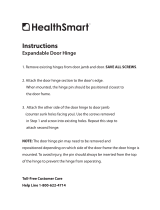
INSTALLATION INSTRUCTIONS
for Interior Door Slabs (JII110)
Consult your local building code official for applicable building codes and
regulations. Local building code requirements supersede recommended
installation instructions.
Note to Installer: Provide a copy of these instructions to the building
owner. By installing this product, you acknowledge the terms and
conditions of the limited warranty as part of the terms of the sale.
Thank you for selecting JELD-WEN products. Attached are JELD-WEN’s
recommended installation instructions for all types of wood Interior
door slabs including molded, ush, custom carved and stile and
rail. Read these instructions thoroughly before beginning. They are
designed to work in most existing applications however; existing
conditions may require changes to these instructions. If changes are
needed, they are made at the installer’s risk. For installations other
than indicated in these instructions, contact a building professional.
IMPORTANT INFORMATION AND GLOSSARY
SAFETY AND HANDLING
Estimated Install
Time for New
Construction
First Time: 1½ hr
Experienced:
¾ hr
Professional:
½ hr
12
6
1
11
2
10
3
9
8 4
7 5
GLOSSARY
Head Jamb
The horizontal jamb across the top of the opening.
Hinge
Metal component that attaches the slab to the jamb and allows the slab
to swing open and closed.
Hinge Jamb
The side jamb the hinges are mounted in.
Hinge Leaves
The at parts of the hinge that mount to the jamb and slab.
Hinge Pin
Pin that holds the hinge leaves together and allows them to pivot.
Hinge Route
Mortise in the jamb and slab the same prole as the corresponding
hinge leaf.
Jambs
Framework attached to the structure that the slab is mounted to, or
hung in.
Panel
Component of the slab lling the spaces between the stiles and rails.
Pilot Hole
A drilled hole that is no larger than the body of the screw (minus
thethreads).
Rail
Horizontal members of the door slab.
Slab
The operating part of the door assembly that swings open and closed
inside a frame.
Stile
Vertical members of the door slab.
Stop
Component xed to the inside the jamb that the slab closes against.
Strike Jamb
The side jamb that contains the latch strike to hold the slab closed.
Please allow sufcient time to properly prepare the opening, install
theslab, and ensure its proper operation.
SAFETY
• Read and fully understand ALL manufacturers’ instructions before
beginning. Failure to follow proper installation and nishing
instructions may result in the denial of warranty claims for
operational performance problems.
• Do not work alone. Two or more people are recommended. Use safe
lifting techniques.
• Use caution when handling glass. Broken or cracked glass can cause
serious injury.
• Wear protective gear (e.g. safety glasses, gloves, ear protection, etc.).
• Operate hand/power tools safely and follow manufacturer’s
operating instructions.
• If disturbing existing paint, take proper precautions if lead paint is
suspected (commonly used before 1979). Your regional EPA (www.
epa.gov/lead) or Consumer Product Safety Commission ofces provide
information regarding regulations and lead protection.
• WARNING: Drilling, sawing, sanding or machining wood products
generates wood dust, a substance known to the State of California to
cause cancer. Use a respirator or other safeguards to avoid inhaling
wood dust.
MATERIALS AND SLAB HANDLING
• Allow doors to acclimate for at least 24 hours to local conditions
before installation or nishing.
• Store slabs in a dry, well-ventilated protected area off of the oor.
Buildings where humidity and temperature are controlled provide
thebest storage facilities (recommended conditions 30%-50%
Relative Humidity and 50°F to 90°F).
• Protect from exposure to direct sunlight during storage.
• Handle doors with clean hands or while wearing clean gloves.
• Lift and carry doors to move, do not drag across one another.
• Heed material manufacturers’ handling and application instructions.
• Install only into vertical walls and when conditions are dry.
IF INJURY OCCURS, IMMEDIATELY SEEK MEDICAL ATTENTION!







